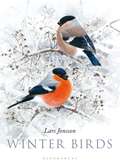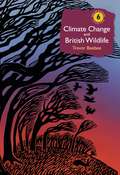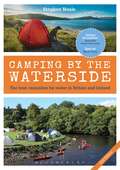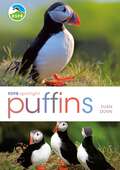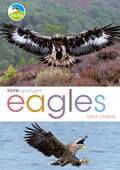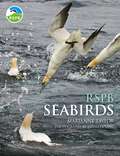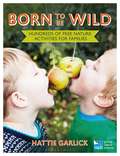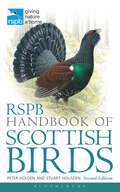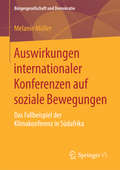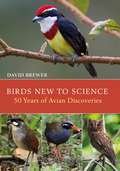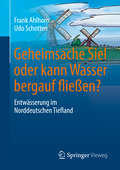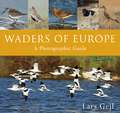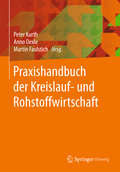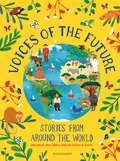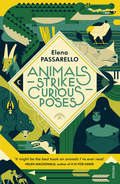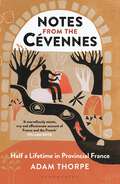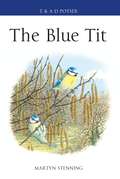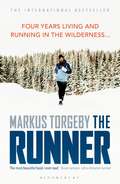- Table View
- List View
The Dark Stuff: Stories from the Peatlands
by Donald S. MurrayDonald S. Murray spent much of his childhood either playing or working on the moor, chasing sheep across empty acres and cutting and gathering peat for fuel. The Dark Stuff is an examination of how this landscape affected him and others. Donald explores his early life on the Isle of Lewis together with the experiences of those who lived near moors much further afield, from the Highlands and Islands of Scotland to the Netherlands, Germany, Ireland and even Australia. Examining this environment in all its roles and guises, Donald reflects on the ways that for centuries humans have represented the moor in literature, art and folktale, and he reveals how in some countries, these habitats remain an essential aspect of their industrial heritage and working life today. On his journey, Donald confronts the unexpected – how Europe's peatlands are part of the dark heart of that continent, playing a crucial role in the history of crime and punishment in several countries. He also examines our current perception of moorland, asking how – for the sake, perhaps, of our planet's survival – we can learn to love a landscape we have all too often in our history denigrated, feared and despised.
Winter Birds
by Lars JonssonIn this stunning book, Lars Jonsson celebrates and explores the beauty of the birds that surround him during the Swedish winter months. Inspired by the desolate, wintry landscapes, the dazzling light and the stark contract of colours he observes against the snow, Jonsson has created an unparalleled collection of art.Jonsson illustrates each bird in his classic style, and his text provides information on their behaviour and insights into how to identify them as he shares personal observations as both an artist and ornithologist. This unique combination offers an intimate and compelling opportunity to better understand the method behind one of the world's preeminent bird artists.
Saltmarsh (British Wildlife Collection)
by Clive Chatters“Saltmarshes are often remote, inhospitable places, neither land nor sea, as hard to pin down as they are to navigate. In this saline odyssey, Clive Chatters has explored his favourite creeks, pools and mudflats to bring us an absorbing celebration of the ecology, biology, geology and history of this scarce and mysterious habitat. There are Tadpole Shrimps, and rare sedges, waders and Wild Celery – even inland saltmarshes – in this tour de force by a superb naturalist and writer.“ BRETT WESTWOOD, naturalist, author and radio presenter Saltmarshes are among Britain's most diverse and dynamic landscapes. They abound around our shores but may also be found inland and at altitude – wherever water, salt and vegetation combine. The species they support range from extreme rarities of specialised habitats to the less demanding denizens of coastal wetlands. Here is a landscape of international importance for migratory birds, endemic plants and an exceptional variety of invertebrates. Clive Chatters has a lifetime's affinity with saltmarshes. In this fifth volume of the British Wildlife Collection, he celebrates their natural history and diversity, from the highly distinctive marshes in the Scottish Highlands to the urban remnants of the Thames estuary now engulfed within the capital. By examining the past of these complex habitats, we can gain an insight into how they have developed, and an understanding of their relationship with people. In addition to their exceptionally diverse natural history, saltmarshes are sources of food and medicine, they play a pivotal role in flood defence and carbon sequestration, and have inspired artistic endeavour.
Climate Change and British Wildlife (British Wildlife Collection)
by Trevor Beebee“Fascinating but frightening, compelling and concerning … this book brings together all you need to know about how the climate is impacting wildlife.”CHRIS PACKHAMThere is no escaping the fact that the British climate is changing, and our wildlife is changing with it. In this remarkable account, Trevor Beebee examines the story so far for our plant, fungi and animal species. Warmer and wetter winters, combined with longer summers, have worked to the advantage of plants such as the rare Lady Orchid,and a whole range of insects. The UK is also hosting new arrivals that come in on the wing. But there is adversity, too. Alpine plants and seabirds – particularly Kittiwakes – are suffering declines as our countryside warms. Given the evidence so far, can we predict what the future holds for our British ecosystems?
Camping by the Waterside: The Best Campsites by Water in Britain and Ireland: 2nd edition
by Stephen NealeThis stylish and inspiring book contains all the information campers need to make the most of the wonderful waterside locations throughout the UK and Ireland. Covering all kinds of camping (caravan, campsite and wild), the book starts by showing how to plan your trip, what gear to take and how to get stuck into all the fantastic water-based activities on offer, such as sailing, kayaking, angling, surfing and wild swimming. Tip boxes, top 10 features and gorgeous photos combine to give readers all the knowledge and inspiration they need to get out there, whether they're on their own, part of a family or with a group of friends.The main part of the guide is organised by region, but also searchable by activity. Each region has an overview, and within it the best sites to visit, with useful information (best times of year to go, activities on offer, facilities, cost), advice on most attractive pitches, contact details and photos. There is a huge variety of sites here, all with something unique to offer, and helpful maps plot each one clearly.With a Foreword by One Man and his Campervan's Martin Dorey, this is the essential guidebook for all campers, showing how it really is possible to pitch up in paradise.This 2nd edition is thoroughly updated throughout, featuring new campsites and photography.
Bewertung der Nachhaltigkeit chemischer Substanzen: Die Methode ‚SusDec‘ als schutzgutbezogenes Nachhaltigkeitsindikatorensystem
by Marian MischkeMarian Mischke entwickelt mithilfe der Methode ‚Sustainable Decisio‘ (SusDec) ein integratives Indikatorensystem, mit dem die Nachhaltigkeit von Produktsystemen chemischer Substanzen vergleichend untersucht und bewertet werden kann. Es werden Schutzgüter definiert, Indikatorergebnisse zur Berechnung der Mehrbelastung herangezogen und das nachhaltigere Produktsystem ausgewählt. ‚SusDec‘ verlässt damit den Weg der einfachen Produktanalyse hin zu einer mehrere Betrachtungsebenen umfassenden Nachhaltigkeitsanalyse bei gleichzeitiger gleichberechtigter Berücksichtigung aller drei Nachhaltigkeitsdimensionen.
RSPB Spotlight: Puffins (RSPB)
by Euan DunnEnduringly popular, Puffins are perhaps our most iconic species of bird, and are the most immediately identifiable of seabirds with their decorative bills and clown-like gait. Yet when they take to the air they wheel and turn with great agility and underwater these stocky little birds use short specially adapted wings to propel themselves through the water in pursuit of small fish.Surprisingly little was known about Puffin ecology until recently thanks to their preferred breeding habitat being underground on remote islands or hard-to-reach coastlines. Now Euan Dunn discloses all we have learnt about them as a result of technological advances, and provides a revealing account of their life cycle, behaviour and breeding, what they eat, how they interact in their busy colonies, and where they migrate to in winter. Euan also exposes the mounting threats Puffins face and offers advice on the best places to see them.Each Spotlight title is carefully designed to introduce readers to the lives and behaviour of our favourite birds and mammals.
RSPB Spotlight: Eagles (RSPB)
by Mike UnwinEagles are among the most impressive hunters of the animal world. Their predatory prowess and flying skills have imbued them with a romance and mystique that runs deep in our culture and has elevated them to emblems of freedom and power across the globe. At the same time, however, people have long seen eagles as competitors. Reviled by farmers and gamekeepers as snatchers of livestock, many species have been driven into decline by persecution and disturbance.Two species of eagle occur in Britain - among 60 worldwide - and are the focus of this book. The regal Golden Eagle is the definitive 'true' eagle and occurs in wilderness areas across the northern hemisphere; the even larger White-tailed Eagle, reintroduced to the UK after historic extinction, belongs to the separate 'sea eagles' genus. These two spectacular birds are both very rare – confined largely to the remote Scottish Highlands – and a sighting of either is one of the UK's most exciting and sought-after wildlife experiences.This highly readable study looks separately at both UK eagles, exploring how each is adapted as an apex predator in its own environment, and explores the relationship between the two. Separate chapters cover all aspects of the birds' biology and lifestyle, from defending their vast territories to raising their young. Fascinating secrets are revealed, including the brutal truth behind 'Cain and Abel' syndrome. The book also takes a look at other eagles around the world, placing the two UK species within this broader context. Finally, it examines the complex relationship that humans have enjoyed with eagles since time immemorial, spanning both culture and conservation, and offers expert tips on where and how you can watch these magnificent birds for yourself.The Spotlight series introduces readers to the lives and behaviours of our favourite animals with eye-catching, colour photography and informative expert text.
RSPB Seabirds (RSPB)
by Marianne Taylor David TiplingSeabirds are the living links between land, air and sea. They enjoy a freedom that even humans, with all our technological assistance, can barely imagine. Many species travel mind-boggling distances across the length and breadth of our planet before returning to land to breed in large, deafening and confusingly crowded colonies. Yet within this commotion each mated pair forms a bond of extreme closeness and tenderness that survives separation each winter and may persist for decades. The long and geologically varied coastline of the British Isles provides homes for internationally important numbers of breeding seabirds. Visiting their colonies is always unforgettable, whether they are cliff-faces packed with Guillemots, islands white-capped by clustered Gannets on their nests, flat beaches crowded with screaming Arctic Terns or seaside rooftops overlaid with a second townscape of nesting gulls. The changing fortunes of these seabird cities reveal to us the health of the vast, unseen but incredibly rich marine world that surrounds us. RSPB Seabirds showcases some of our most exciting and enigmatic bird species as vital and living components of one of our greatest natural assets: our coastline. The author presents detailed biographies of all the seabird species that breed in and around the British Isles, and also looks at the many species that breed elsewhere but which, regularly or occasionally, visit British waters. Every page of this sumptuous book features beautiful photographs of wild seabirds engaged in their daily work of hunting, travelling, protecting themselves and their territories, courting and raising a family.
Born to Be Wild: Hundreds of free nature activities for families (RSPB)
by Hattie Garlick Nancy HoneyWant to save cash, your child's imagination and possibly even the planet? This is the book you need.Packed with great photos of real families in the outdoors, Born to Be Wild contains easy-to-follow instructions for activities that require nothing more sophisticated than a small person's imagination and access to a little outdoor space.Nature lays on magical materials for free each season, from fallen leaves and twigs, moulted feathers, sand and shells, to mud, puddles and rain. Everything else you'll need for these activities is already hiding in your cupboards at home. No expensive art supplies of outward-bound kit required. All you need are the toolkit items at the front of the book - ordinary household essentials like scraps of paper, string, glue, recycled food containers and an empty jar or two.Along the way Hattie talks to families, organisations and communities who have rebuilt their relationships with nature with extreme or inspiring results, and she introduces scientists, psychologists and other experts who explain why, as modern families, we should revive our waning relationships with nature, whatever age or stage we're at.
RSPB Handbook of Scottish Birds: Second Edition (RSPB)
by Peter Holden Stuart HousdenThe RSPB Handbook of Scottish Birds is the ideal reference for keen birdwatchers and visitors to Scotland alike, and this fully updated second edition is richer and more comprehensive than ever. Over 250 species are covered in detail with each account including information on identification, voice, habits, habitat, food, breeding, ecology, seasonal movements, population and conservation. More than 1,000 superb colour illustrations by some of the world's leading bird artists are integrated into the text for easy reference. This second edition features newly added Gaelic names, updated distribution maps, and also incorporates the latest information on the conservation status of each species.- Concise text offers a 'biography' of each species in simple, non-technical language- Practical, easy-to-use format- Updated distribution maps show resident species, summer and winter visitors, and passage migrants
Auswirkungen internationaler Konferenzen auf soziale Bewegungen: Das Fallbeispiel der Klimakonferenz in Südafrika (Bürgergesellschaft und Demokratie)
by Melanie MüllerMelanie Müller untersucht die Folgen der Integration der verschiedenen Weltregionen in das System der Vereinten Nationen für soziale Bewegungen. Am Fallbeispiel Südafrika zeigt sie, dass internationale Konferenzen als ‚transformatives Ereignis‘ charakterisiert werden können, das Entwicklungen innerhalb von sozialen Bewegungen in Gang setzt und diese dadurch mittelfristig verändert. Unter Rückgriff auf vier Ansätze der Protest- und Bewegungsforschung beschreibt die Autorin, dass es Bewegungsorganisationen gelingt, Ressourcen im Vorfeld und während der Konferenz zu mobilisieren und neue politische Gelegenheiten zu erschließen. Die Bewegungsorganisationen entwickeln neue Frames, die über den Zeitraum der Konferenz hinaus einzelne Netzwerke miteinander verbinden. Zentraler Bezugspunkt für die Bewegungsorganisationen bleibt dabei immer aber die nationale Ebene und die eigene Regierung und nicht – wie zu erwarten wäre – die internationale Ebene.
Rogue Waves: Anatomy of a Monster
by Michel OlagnonRogue waves remain something of a mystery. Long believed to be a myth or an exaggeration, they haven't been the subject of any kind of serious in-depth research - until now. This book makes rigorous marine science accessible to all, exploring the causes and frequency of rogue waves, and the reasons why some waves become killer monsters.With anecdotes, historical reports and objective analysis, all illustrated with evocative and rare photographs, Michel Olagnon's groundbreaking book is a definitive contribution to our understanding of this much-feared phenomenon. Amongst other questions in the book, he examines:- How are rogue waves created?- How do they live and die?- Are there different types?- Do they appear from nowhere?- Can ships and boats cope with them?- What lessons can be learned from past encounters?- Will meteorologists be able to provide warnings?Authoritative but highly readable, this is a fascinating and unique study into rogue waves, offering insights for all readers, but crucial advice for those who might encounter this dangerous phenomenon at sea.
Birds New to Science: Fifty Years of Avian Discoveries (Helm Photographic Guides)
by David BrewerAmazing as it might sound, ornithologists are still discovering several bird species each year that are completely new to science. These aren't all obscure brown birds on tiny islands – witness the bizarre Bare-faced Bulbul from Laos (2009), spectacular Araripe Manakin from Brazil (1998), or gaudy Bugun Liocichla from north-east India (2006).Birds New to Science documents more than half a century of these remarkable discoveries, covering around 300 species. Each account includes the story of discovery, a brief description of the bird (many with accompanying photographs), and details of what is known about its biology, range and conservation status.Written in an engaging style, this is a rich reference to an incredible era of adventure in ornithology.
Geheimsache Siel oder kann Wasser bergauf fließen?: Entwässerung im Norddeutschen Tiefland
by Frank Ahlhorn Udo SchottenThema des vorliegenden Buches ist der Umgang mit dem Wasser an der niedersächsischen Küste (hier: die Entwässerung der niedrig liegenden Landschaft), eine fundamentale Angelegenheit für die Menschen, die hier leben und arbeiten. Für ein junges Zielpublikum wird unterhaltsam erläutert, wohin das Wasser fließt und welche Anstrengungen unsere Vorfahren unternommen hatten, damit wir in dieser Landschaft (über)leben können. Darüber hinaus werden Veränderungen, die z. B. über den Klimawandel auf diese Landschaft einwirken, in die Entdeckungsreise der vier Protagonisten eingebunden.
Waders of Europe
by Lars GejlWaders are spectacular members of our avifauna. They are especially prevalent along coasts and in wetlands during the spring and autumn migration periods, when members of several species may perform dramatic flocks that wheel and turn in flight. While waders are often particularly striking in summer plumage, identifying these birds outside the breeding season can be problematic for even the most confident of birdwatchers.Waders of Europe is the ultimate guide to wader identification, ecology and biology. Through outstanding photography and concise, detailed text, this book is indispensable for anyone interested in learning more about waders, and is an invaluable tool for identifying birds to species level in the field.
Praxishandbuch der Kreislauf- und Rohstoffwirtschaft
by Peter Kurth Anno Oexle Martin Faulstich Armin Rockholz Johannes Kirchhoff Markus Gleis Peter Quicker Christian Kabbe Gerhard Rettenberger Holger Alwast Michael Krüger Torsten Wenk Alexander De Diego Rainer Geesmann Dominik Lück Christine Radeloff Lammers Thomas Joachim Wuttke Sandra Giern Maren Heidmann Andreas Zühlsdorff Markus Figgen Rebecca Schäffer Joachim Hagmann Antje Wittmann Jens Gruber Jörg Karenfort Hendrik Reffken Lepper Christoph Hendrik Kempkes Andreas Bruckschen Dirk Mellen Tobias Becker Simon Obert Ochs Annette Aloys Oechtering Matthias Heinen Hans-Bernhard Rhein Laurent Hequet Matthias Staub Anne Nikodem Ralf Schmitz Thorsten Feldt Sabine Tirrel Ralf Reuter Isabelle Yoon Jens Loschwitz Jasmin Klöckner Berthold Heuser Klaus-Axel Riemann Ralf Gruner Klaus Fricke Sigrid Hams Sabine Flamme Christoph Bildstein Fabian Kraus Hans-Dieter Huber Ewa Harlacz Jan Seelig Kai Münnich Sebastian WankaDie traditionell vielschichtige Abfallwirtschaft entwickelt sich mit der ihr eigenen Dynamik zur Kreislauf- und Rohstoffwirtschaft. Im vorliegenden Handbuch werden erstmalig alle wesentlichen Aspekte dieses Wirtschaftssektors – fachübergreifend und interdisziplinär – behandelt. Neben den in der Ressourcenwirtschaft relevanten rechtlichen Fragestellungen (u. a. Stoffrecht, Verwaltungsrecht, Haftung und Transport) sind die unterschiedlichen Stoffströme dargestellt (z. B. Glas, Papier, Verpackung, Metalle und Elektronik-Altgeräte, Bioabfälle) sowie Anlagentechnik und Logistik beschrieben (Abfallwirtschaftssysteme, Abfallbehandlung, Deponierung). Bei der Auswahl der Themen und Autoren lag der Schwerpunkt auf Praxisrelevanz und Praxisbezug.Der Inhalt• Rechtlicher Rahmen: Beginn und Ende der Abfalleigenschaft, Stoffrecht, Einstufung von Abfällen, Nachweis- und Registerführung, Reichweite und Grenzen des staatlichen Entsorgungsmonopols, Handeln und Makeln, Exportrecht, Anlagenzulassungsrecht, Entsorgungsvertragsrecht, Vergaberecht, Kartellrecht, Straf- und Bußgeldrecht, Umweltmanagementsysteme• Stoffströme und Ressourcenwirtschaft: Glasrecycling, Altpapier, Kunststoffe, Verpackungsabfälle, Bioabfälle, Klärschlamm, Altholz, Elektroaltgeräte, Lithiumbatterien, NE-Metalle, Gewerbeabfall, mineralische Bauabfälle, steuerliche Konsequenzen der Energieströme• Technik, Logistik, Anlagen: Abfallwirtschaftskonzepte, Recyclingbörsen, IT in der Abfallwirtschaft, Anlagenplanung, Sammelfahrzeuge, Demontage, Verbrennung, Verbrennungsrückstände, Phosphorrecycling, Deponierung, DeponierückbauDie Zielgruppe• Verantwortliche in Unternehmen der Kreislauf- und Rohstoffwirtschaft, Anbieter umwelttechnischer Lösungen, Berater• Fachpersonal in öffentlichen Entsorgungsbetrieben, Umweltbehörden und Ministerien• Juristen und Rechtsanwälte
Voices of the Future: Stories from Around the World
by Irina BokovaA wonderful anthology of eight stories addressing children's rights and sustainable development, written by child authors from all around the world and produced in conjunction with UNESCO's Voices of Future Generations initiative.UNESCO's Voices of Future Generations initiative works to empower children all around the world. The stories in this book are written by children aged between 8 and 12 from every corner of the globe: Canada, Mexico, Papua New Guinea, Samoa, South Africa, Taiwan, Uruguay and United Arab Emirates. With beautiful, full colour illustrations throughout by four talented illustrators, Jhonny Nunez, Giovana Medeiros, Marco Guadalupi and Mona Meslier Menaua, this book is the perfect way to engage children with the issues facing the planet and the lives of children in other countries.The children's stories are imaginative, empowering and inspiring. They focus on the UN Convention on the Rights of the Child and the Sustainable Development Goals and present likeable characters who go on problem-solving adventures to fix the problems faced in each region. The book features a foreword by Irina Bokova, Director General of UNESCO.'... and together, the children could build a better future.'Book band: Dark Blue
Animals Strike Curious Poses
by Elena PassarelloBeginning with Yuka, a 39,000-year-old mummified woolly mammoth recently found in the Siberian permafrost, each of the sixteen essays in Animals Strike Curious Poses investigates a different famous animal named and immortalised by humans. Here are the starling that inspired Mozart with its song, Darwin’s tortoise Harriet, and in an extraordinary essay, Jumbo the elephant (and how they tried to electrocute him). Modelled loosely on a medieval bestiary, these witty , playful, provocative essays traverse history, myth, science and more, introducing a stunning new writer to British readers.
RSPB British Naturefinder (RSPB)
by Marianne TaylorMost wildlife books are designed to help you identify the animals you have seen. This book is different. In this new, user-friendly guide one British species is highlighted per page, and each account explains in accessible text how to find it, where to find it and how to ensure you have the most rewarding wildlife-watching experiences.Within the 'How to Find' section, author Marianne Taylor explains the best time to look for each species, its preferred habitat, and offers tips to help make your search easier or more productive. In 'Watching Tips' she advises on how to get the most from your encounter, how to observe the species at length and with luck witness its most fascinating behaviour. A colour panel indicates each species' geographical distribution on a map, including 'Super Sites' where the species is particularly abundant or regular. A calendar shows when each species is present or active in the UK to help you plan your visits to nature reserves. Colour photos serve as a reminder of each species' key identification features.In total, RSPB British Naturefinder features nearly 300 species, and it includes all British mammals, reptiles and amphibians, along with a carefully chosen selection of other British animals of interest, such as butterflies, moths, dragonflies, spiders and fishes.
Notes from the Cévennes: Half a Lifetime in Provincial France
by Adam ThorpeAdam Thorpe's home for the past 25 years has been an old house in the Cévennes, a wild range of mountains in southern France. Prior to this, in an ancient millhouse in the oxbow of a Cévenol river, he wrote the novel that would become the Booker Prize-nominated Ulverton, now a Vintage Classic. In more recent writing Thorpe has explored the Cévennes, drawing on the legends, history and above all the people of this part of France for his inspiration. In his charming journal, Notes from the Cévennes, Thorpe takes up these themes, writing about his surroundings, the village and his house at the heart of it, as well as the contrasts of city life in nearby Nîmes. In particular he is interested in how the past leaves impressions – marks – on our landscape and on us. What do we find in the grass, earth and stone beneath our feet and in the objects around us? How do they tie us to our forebears? What traces have been left behind and what marks do we leave now? He finds a fossil imprinted in the single worked stone of his house's front doorstep, explores the attic once used as a silk factory and contemplates the stamp of a chance paw in a fragment of Roman roof-tile. Elsewhere, he ponders mutilated fleur-de-lys (French royalist symbols) in his study door and unwittingly uses the tomb-rail of two sisters buried in the garden as a gazebo. Then there are the personal fragments that make up a life and a family history: memories dredged up by 'dusty toys, dried-up poster paints, a painted clay lump in the bottom of a box.' Part celebration of both rustic and urban France, part memoir, Thorpe's humorous and precise prose shows a wonderful stylist at work, recalling classics such as Robert Louis Stevenson's Travels with a Donkey in the Cévennes.
Urban Cooperation and Climate Governance: How German and Indian Cities Join Forces to Tackle Climate Change (Energiepolitik und Klimaschutz. Energy Policy and Climate Protection)
by Jan BeermannJan Beermann addresses persistent research gaps in urban climate governance and North-South cooperation. He compares the form, processes and outcomes of four local climate protection projects conducted as part of German-Indian urban cooperation and explores the conditions associated with the success and/or failure in these initiatives. The study concludes that North-South city partnerships struggle to fully realise their potential to foster global climate protection efforts, specifically in terms of post-project sustainability, multi-level governance coordination, and mutuality. On the basis of these findings, practical policy recommendations on how to maximise the outcomes and broaden the scope of urban climate cooperation are provided.
Meadows (British Wildlife Collection)
by George PeterkenMeadows, the second volume of a major new series of books on British natural history, provides one of the most wide-ranging and eloquent treatments of this most quintessential British habitat. Yet the flower-rich hay meadows that have inspired writers and artists for hundreds of years have almost disappeared from our countryside. In this exceptional work, George Peterken, one of our most respected ecologists, brings together years of research and discovery from his travels across Britain and Europe, as well as an understanding borne out of caring for his own meadows, to produce a book that will put this often misunderstood habitat back in the public's eye. Filled with beautiful images of meadows and their denizens, this is a book everyone with an interest in this iconic habitat will want to own.
The Blue Tit
by Martyn StenningSporting a mix of blue, yellow, white, green and black, the unmistakable Blue Tit reflects the colours of a planet affected by a burgeoning human population. Fortunately, Blue Tits are adapting well to modern humanity, taking advantage of our propensity to feed birds in our gardens and provide boxes for them to nest in. In turn, this feisty little species provides an excellent model for biological research. This book is the result of a personal quest by author Martyn Stenning to bring together a range of discoveries into one accessible volume.The Blue Tit begins by inviting readers into the intimate lives of these birds as they attempt to reproduce, describing the many challenges they face when rearing their offspring. The story moves on to the fluid state of Blue Tit classification across the native Palearctic range, before progressing into population structure, lifetime ecology and an exploration of factors that determine breeding success. It culminates with an in-depth look at research over the years, followed by a selection of personal anecdotes and an overview of Blue Tit appearances in folklore and poetry.This book provides a definitive record of the biology and ecology of one of our most popular, intelligent and charismatic birds.
The Runner: Four Years Living and Running in the Wilderness
by Markus TorgebyMarkus Torgeby was just 20 years old when he headed off into the remote Swedish forest to live as a recluse and dedicate himself to his one true passion, running… He lived in a tent in the wilderness, braving the harsh Swedish winters - for four years. This is his story. A bestseller in Sweden, the book is a powerful exploration of running and personal wellbeing.During his teenage years Markus Torgeby turned out to be a very talented long-distance runner. It didn't take long before he was discovered by an enthusiastic coach who set very high goals. However, while Markus performed brilliantly in training, during competitions he often failed inexplicably. These pressures, along with the burden of having to care for a MS-suffering mother took their toll, and when an injury put an end to Markus's running career, he lost his foothold in life. In order not to completely go under, he chose to do something that most of us only dream of: to escape the modern world. Aged 20, Markus Torgeby decides to move to one of the most isolated and cold regions of northern Sweden. He's going to live right in the middle of the forest, alone. There he lived as a recluse for four years. The only thing he kept was his running - his 'drug', the one thing he can't be without. His time alone would prove to be more than an escape and was in fact a search for a direction in life. The Runner is a unique and powerful book which can be read both as a portrait of an extraordinary man as well as a fascinating exploration of running and personal wellbeing. The book will certainly strike a chord with the running audience, but it has the potential to find a wider readership than that.

